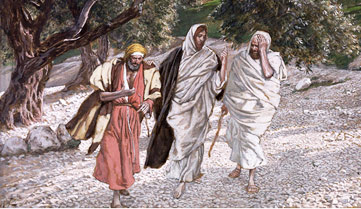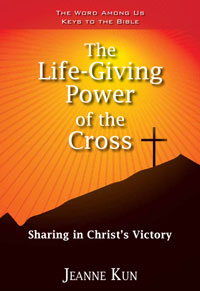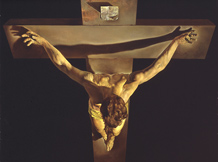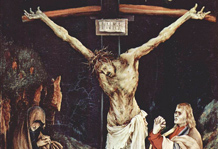April
2012
- Vol. 59

The
Triumph of the Cross:
“The
Lord has risen indeed”
.
by Jeanne Kun
When
Death and Life contended,
the
Lord of life was slain.
A
battle strangely ended:
he
won, and lives to reign.
– Easter
Sequence, Victimae Paschali Laudes.
Was it not necessary that the Messiah should
suffer these things and then
enter into his glory?”(Luke 24:26). The key to
understanding Jesus’ mission
to save and restore humanity to union with the
Father is found in this
question and the explanation Jesus gave to his
bewildered followers. As
he opened the Scriptures to them (24:27), he
showed that it was by his
crucifixion that he fulfilled his Father’s plan
for the salvation of the
world. Christians can now look upon the cross not
as a shameful instrument
of torture but as a sign of victory. Jesus’
crucifixion was a battle that
ultimately delivered all humankind from the power
of Satan – from sin and
from death. And we, who are in Christ, share in
this victory.
| Jesus
went to his death on Golgotha knowing
that it was the path to his
glorification as well as our
salvation. |
Jesus went to his death on Golgotha knowing
that it was the path to
his glorification as well as our salvation. In
his last public discourse,
he had indicated how – and why – he would soon
die, saying, “Now my soul
is troubled. And what should I say – ‘Father,
save me from this hour’?
No, it is for this reason that I have come to
this hour. Father, glorify
your name. . . . And I, when I am lifted up from
the earth, will draw all
people to myself” (John 12:27-28, 32-33). And on
the very eve of his crucifixion,
Jesus prayed,
Father, the hour
has come; glorify your Son so that the Son
may glorify you, since you have
given him authority over all people, to give
eternal life to all whom you
have given him. And this is eternal life,
that they may know you, the only
true God, and Jesus Christ whom you have
sent. I glorified you on earth
by finishing the work that you gave me to
do. So now, Father, glorify me
in your own presence with the glory that I
had in your presence before
the world existed. (John 17:1-5).
The Fathers of the Church even refer to the cross
as Jesus’ “throne of
glory.” The crucifixion led ultimately to Jesus’
resurrection and ascension
into heaven, where he is gloriously enthroned at
the right hand of the
Father (Hebrews 1:3).
Jesus showed his followers the wounds in his
hands and feet and side
to assure them that his resurrected body was the
same body that had been
crucified (Luke 24:39-40; John 20:27). As the
Catechism of the Catholic
Church explains, “[Jesus’] authentic, real body
possesses the new properties
of a glorious body: not limited by space and
time but able to be present
how and when he wills; for Christ’s humanity can
no longer be confined
to earth and belongs henceforth only to the
Father’s divine realm” (645).
When death entered the world through sin, we
lost sight of our immortality
and our heavenly destiny. But, because of
Christ’s passion and glorification,
we can anticipate with joy that, after death,
our own perishable, physical
bodies will be raised up and vested with
unimaginable splendor. And even
now, “he who raised Christ from the dead will
give life to [our] mortal
bodies also through his Spirit that dwells in
[us]” (Romans 8:11). Day
by day the risen Lord brings healing, freedom,
and transformation to us
and produces the fruits of the Spirit in us;
ultimately, in our imperishable
bodies, we will share eternal glory with Jesus
and the Father in heaven.
It is awesome to realize that Jesus retains the
marks of his wounds
on his resurrected body. They are a badge of his
sufferings, like the battle
scars proudly worn by a veteran. As Pope
Benedict XVI has noted, “The Lord
took his wounds with him to eternity. He is a
wounded God. . . . His wounds
are a sign for us that he understands and allows
himself to be wounded
out of love for us. ” The scars of Jesus’
crucifixion are the sign of the
price he willingly paid with his own body for
our redemption, the mark
of his passionate love for us.
When the risen Lord appeared to the eleven, he
told them: “‘Everything
written about me in the law of Moses and the
prophets and the psalms must
be fulfilled.’ Then he opened their minds to
understand the scriptures,
and said to them, ‘Thus it is written, that the
Christ should suffer and
on the third day rise from the dead’” (Luke
24:44-46). From its earliest
days the Christian church recognized the
significance of Christ’s fulfillment
of prophecy; its faith in Jesus the Messiah was
rooted in God’s word. As
St. Paul attested, “I delivered to you as of
first importance what I also
received, that Christ died for our sins in
accordance with the scriptures,
that he was buried, that he was raised on the
third day in accordance with
the scriptures” (1 Corinthians 15:3-4).
Reflect!
1.
1. When we say the Apostles’ Creed, we proclaim
our faith in Jesus’ resurrection
and “in the resurrection of the body”—that is,
in our own future resurrection.
Although we cannot comprehend now how our bodies
of flesh will be transformed,
we know that “the dead will be raised
imperishable, and we will be changed.
. . . When this perishable body puts on
imperishability, and this mortal
body puts on immortality, then the saying that
is written will be fulfilled:
‘Death has been swallowed up in victory’” (1
Corinthians 15:52, 54).
How do you show respect for your physical
body, which is destined
for immortality? How might reflection on your
own future resurrected body
affect what you do in daily life?
2.
Read and reflect on the following Scripture
passages to deepen your appreciation
of the victorious nature of Christ’s
resurrection and the eternal life
that the faithful will come to share with him in
heaven:
A week later [Jesus’] disciples were
again in the house, and
Thomas was with them. Although the doors were
shut, Jesus came and stood
among them and said, “Peace be with you.” Then
he said to Thomas, “Put
your finger here and see my hands. Reach out
your hand and put it in my
side. Do not doubt but believe.” Thomas answered
him, “My Lord and my God!”
(John 20:26-28)
Now if Christ is proclaimed as raised
from the dead, how can
some of you say there is no resurrection of the
dead? If there is no resurrection
of the dead, then Christ has not been raised;
and if Christ has not been
raised, then our proclamation has been in vain
and your faith has been
in vain. We are even found to be misrepresenting
God, because we testified
of God that he raised Christ—whom he did not
raise if it is true that the
dead are not raised. For if the dead are not
raised, then Christ has not
been raised. If Christ has not been raised, your
faith is futile and you
are still in your sins. Then those also who have
died in Christ have perished.
If for this life only we have hoped in Christ,
we are of all people most
to be pitied.
But in fact Christ has been raised from the
dead, the first fruits of
those who have died. For since death came
through a human being, the resurrection
of the dead has also come through a human
being; for as all die in Adam,
so all will be made alive in Christ. (1
Corinthians 15:12-22)
For since we believe that Jesus died
and rose again, even so,
through Jesus, God will bring with him those who
have died. For this we
declare to you by the word of the Lord, that we
who are alive, who are
left until the coming of the Lord, will by no
means precede those who have
died. For the Lord himself, with a cry of
command, with the archangel’s
call and with the sound of God’s trumpet, will
descend from heaven, and
the dead in Christ will rise first. Then we who
are alive, who are left,
shall be caught up in the clouds together with
them to meet the Lord in
the air; and so we will be with the Lord
forever. Therefore encourage one
another with these words. (1 Thessalonians
4:14-18)
In the Spotlight
So Must the
Son of Man Be Lifted Up
In
his nighttime conversation with
Nicodemus (John 3:1-15), Jesus
prophetically
alluded to his “lifting up” and
glorification on the cross:
“Just as Moses
lifted up the serpent in the
wilderness, so must the Son of
Man be lifted
up, that whoever believes in him
may have eternal life”
(3:14-15). The
story of the Israelites’
rebellion against God in Numbers
21:5-9 gives
us insight into how we are to
understand Jesus’ mysterious
statement:
The
people
spoke against God and against
Moses, “Why have you brought us
up
out of Egypt to die in the
wilderness? For there is no food
and no water,
and we detest this miserable
food.” Then the LORD
sent poisonous serpents among
the people, and they bit the
people, so that
many Israelites died. The people
came to Moses and said, “We have
sinned
by speaking against the LORD
and against you; pray to the LORD
to take away the serpents from
us.” So Moses prayed for the
people. And
the LORD said to Moses, “Make
a poisonous serpent, and set it
on a pole; and everyone who is
bitten shall
look at it and live.” So Moses
made a serpent of bronze, and
put it upon
a pole; and whenever a serpent
bit someone, that person would
look at the
serpent of bronze and live.
The
bronze
serpent is a “type” or
prefigurement of Christ. By
looking at the image
erected on the pole by Moses,
those who had sinned and been
bitten by the
venomous serpents were cured.
Jesus compares this incident with
his coming
crucifixion to show the purpose of
his being raised up on the cross:
Anyone
who looks on him with faith can
obtain salvation, for the cross is
God’s
remedy or antidote for the sting
of Satan and the poisonous venom
of sin
that infects humanity. As
Benedictine monk and Scripture
scholar Damasus
Winzen wrote: “The fiery serpents
are the symbol of the sins of men,
and
the bronze serpent foreshadows the
one who took on the flesh of sins
without
sin, that through faith in his
death for our sins, we may be
freed from
death” (Pathways in Scripture). |
>
Next:Contemplating
Christ's
Passion, by Jeanne Kun
>
See also:Freedom
from
Sin and Death: "A New Creation"

Excerpted
from The
Life-Giving
Power of the Cross: Sharing in
Christ's Victory, by
Jeanne Kun (The
Word
Among Us Press, © 2011). Used with
permission. This book
can be ordered online.
Jeanne
Kun is President of Bethany
Association and a senior woman
leader in the Word
of
Life Community, Ann Arbor, Michigan,
USA. |
Luke
24:13-47
13
Now on that same day two of them were going
to a village called Emmaus,
about seven miles from Jerusalem, 14and
talking with each other about all
these things that had happened. 15While they
were talking and discussing,
Jesus himself came near and went with them,
16but their eyes were kept
from recognizing him.
17And
he said to them, “What are you discussing
with each other while you walk
along?” They stood still, looking sad.
18Then one of them, whose name was
Cleopas, answered him, “Are you the only
stranger in Jerusalem who does
not know the things that have taken place
there in these days?” 19He asked
them, “What things?”
They
replied, “The things about Jesus of
Nazareth, who was a prophet mighty
in deed and word before God and all the
people, 20and how our chief priests
and leaders handed him over to be
condemned to death and crucified him.
21But we had hoped that he was the one to
redeem Israel. Yes, and besides
all this, it is now the third day since
these things took place. 22Moreover,
some women of our group astounded us. They
were at the tomb early this
morning, 23and when they did not find his
body there, they came back and
told us that they had indeed seen a vision
of angels who said that he was
alive. 24Some of those who were with us
went to the tomb and found it just
as the women had said; but they did not
see him.”
25Then
he said to them, “Oh, how foolish you are,
and how slow of heart to believe
all that the prophets have declared! 26Was
it not necessary that the Messiah
should suffer these things and then enter
into his glory?” 27Then beginning
with Moses and all the prophets, he
interpreted to them the things about
himself in all the scriptures.
28
As they came near the village to which
they were going, he walked ahead
as if he were going on. 29But they urged
him strongly, saying, “Stay with
us, because it is almost evening and the
day is now nearly over.” So he
went in to stay with them.
30When
he was at table with them, he took bread,
blessed and broke it, and gave
it to them. 31Then their eyes were opened,
and they recognized him; and
he vanished from their sight. 32They said
to each other, “Were not our
hearts burning within us while he was
talking to us on the road, while
he was opening the scriptures to
us?”
33That
same hour they got up and returned to
Jerusalem; and they found the eleven
and their companions gathered together.
34They were saying, “The Lord has
risen indeed, and he has appeared to
Simon!” 35Then they told what had
happened on the road, and how he had been
made known to them in the breaking
of the bread.
36
While they were talking about this, Jesus
himself stood among them and
said to them, “Peace be with you.” 37They
were startled and terrified,
and thought that they were seeing a ghost.
38He said to them, “Why are
you frightened, and why do doubts arise in
your hearts? 39Look at my hands
and my feet; see that it is I myself.
Touch me and see; for a ghost does
not have flesh and bones as you see that I
have.” 40And when he had said
this, he showed them his hands and his
feet. 41While in their joy they
were disbelieving and still wondering, he
said to them, “Have you anything
here to eat?” 42They gave him a piece of
broiled fish, 43and he took it
and ate in their presence.
44
Then he said to them, “These are my words
that I spoke to you while I was
still with you—that everything written
about me in the law of Moses, the
prophets, and the psalms must be
fulfilled.” 45Then he opened their minds
to understand the scriptures, 46and he
said to them, “Thus it is written,
that the Messiah is to suffer and to rise
from the dead on the third day,
47and that repentance and forgiveness of
sins is to be proclaimed in his
name to all nations, beginning from
Jerusalem.”
Understand!
1.
Luke reports that Cleopas and his companion
failed to recognize Jesus when
he joined them on the road (24:16). What do
you think might account for
this failure? Do you think the appearance of
Jesus’ resurrected body was
a factor? Why or why not?
2.
How did the two travelers describe Jesus
of Nazareth to their unknown companion
(Luke 24:19-24)? What were their beliefs
about Jesus and their expectations
of him before he had been crucified? Why
were they so disappointed? Why
do you think the two were so “slow of
heart” (24:25) to believe?
3.
What did Jesus stress in his explanation
of the Scriptures concerning himself
to his followers (Luke 24:25-27, 44-46)?
What does this indicate to you
about how the early church viewed the
ancient prophecies of the Hebrew
Scriptures as it formed its understanding
of Christ?
4.
How did the travelers react to Jesus?
Describe the process of their recognition
of Jesus and the effect of his explanation
of the Scriptures upon them.
What does this suggest to you about the
power of the word of God? About
Jesus’ physical appearance? About his
spiritual “presence” and charisma?
5.
Since his death on the cross, how has
Jesus drawn all people to himself,
as he promised (John 12:28)? How is this
connected to his glorification?
In
the Spotlight
Witness
of
the Early Church
 If
you
would understand that the cross is
Christ’s triumph, hear what he
himself
also said: “When I am lifted up,
then I will draw all men to
myself.” Now
you can see that the cross is
Christ’s glory and triumph.
If
you
would understand that the cross is
Christ’s triumph, hear what he
himself
also said: “When I am lifted up,
then I will draw all men to
myself.” Now
you can see that the cross is
Christ’s glory and triumph.
–
Andrew of Crete
No
one, however weak, is denied a
share in the victory of the
cross. No one
is beyond the help of the prayer
of Christ. His prayer brought
benefit
to the multitude that raged
against him. How much more does
it bring to
those who turn to him in
repentance.
–
Leo the Great
Glory
be
to you, O Christ, who laid your
cross as a bridge over death,
that souls
might pass over it from the
dwelling of the dead to the
dwelling of life!
–
Ephrem of Syria
|
Grow!
1.
Like the two disciples on the road to
Emmaus, have you ever failed to recognize
Jesus’ presence or action in your life or
felt downcast and disappointed,
without hope for your future? What were
your prayers to Jesus like then?
How did the Lord reveal himself to you and
encourage you?
2.
How has your knowledge of Old Testament
prophecies that were fulfilled
in Jesus deepened your faith? What
particular word of Scripture has caused
your heart to “burn” within you? Why?
3.
Recall an instance in your life when you
experienced “glory” and/or “victorious
new life” coming out of suffering or what
seemed like failure and defeat.
What did you learn about God and his
redemptive power from this
circumstance?
4.
How does your personal faith in Jesus’
resurrection and the future resurrection
of the dead affect your outlook toward
those around you—mortal men and
women who, along with you, will “put on
immortality” (1 Corinthians 15:53)
and live eternally? How does it affect
your feelings about your own death?
5.
How do you envision Jesus’ glorified body
(Luke 24:36-40; John 20:19-20;
Revelation 1:12-16)? How do you imagine
your own resurrected existence
in heaven?
In
the Spotlight
The
Throne
of Love

The
chief
priests of Jesus’ own people
accused him of falsely
claiming to be
a king (Luke 23:2).
Ironically, it was the gentile
Pilate who, defying
the Jewish elders, ordered
that the title “Jesus of
Nazareth, King of the
Jews” be affixed to the cross
when Jesus was crucified (John
19:19-22).
In the Tradition and writings
of the Church, Jesus’
crucifixion is frequently
called his “enthronement” – an
expression of kingship –
because the cross,
the instrument of his death,
was also recognized as the
means of his glorification
and a sign of his victorious
reign.
The
throne
of this King whom we worship . .
. is the Cross, and his triumph
is the victory of Love, an
almighty love that from the
Cross pours out
his gifts upon humanity of all
times and all places.
–
Pope Benedict XVI
We
venerate the cross as a
safeguard of faith, as the
strengthening of hope
and the throne of love. It is
the sign of mercy, the proof of
forgiveness,
the vehicle of grace and the
banner of peace. We venerate the
cross, because
it has broken down our pride,
shattered our envy, redeemed our
sin, and
atoned for our punishment. . . .
Whatever
we
accomplish for God, whatever we
succeed and hope for, is the
fruit of
our veneration of the cross. By
the cross Christ draws
everything to him.
It is the kingdom of the Father,
the scepter of the Son and the
seal of
the Holy Spirit, a witness to
the total Trinity.
–
Rupert of Deutz
|
Act!
This
week, share your faith in Christ’s
resurrection with someone you know who
is facing challenging circumstances (for
example, physical illness, a financial
crisis, depression, or a sense of
hopelessness). Encourage this person
to hold fast to the “eternal perspective”
that St. Paul offers in Romans
8:18-19 and 22-25:
I
consider that the sufferings of this
present time are not worth comparing
with the glory about to be revealed to us.
For the creation waits with
eager longing for the revealing of the
children of God. . . . We know that
the whole creation has been groaning in
labor pains until now; and not
only the creation, but we ourselves, who
have the first fruits of the Spirit,
groan inwardly while we wait for adoption,
the redemption of our bodies.
For in hope we were saved. Now hope that
is seen is not hope. For who hopes
for what is seen? But if we hope for what
we do not see, we wait for it
with patience.
|